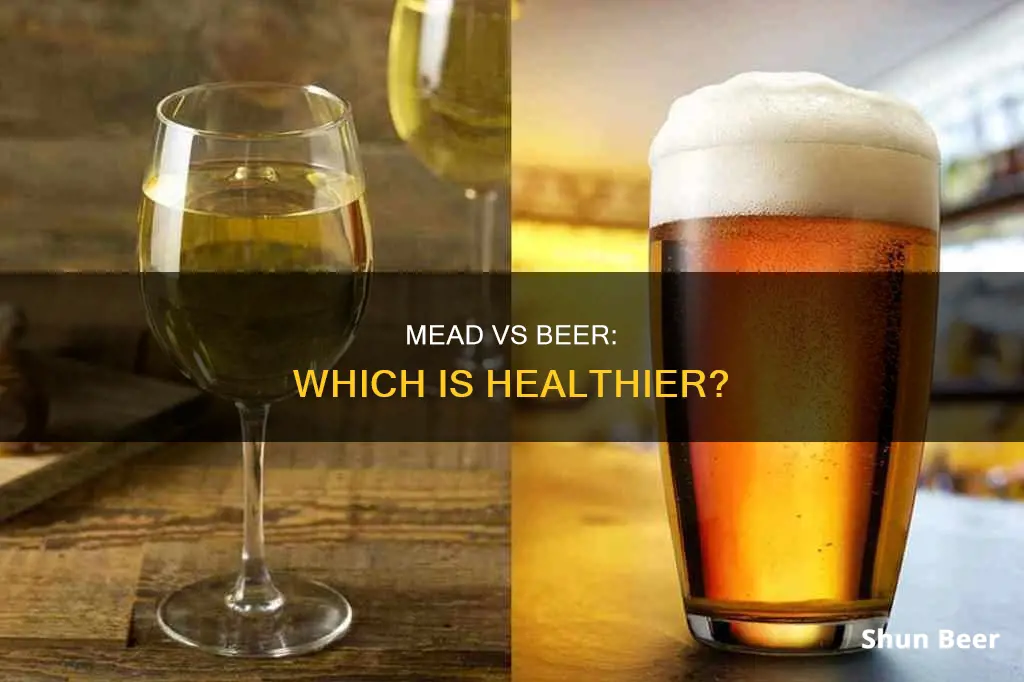
Mead and beer are two popular alcoholic beverages with distinct characteristics and a dedicated fan base. While both drinks have their own unique advantages and appeal, the question of which is healthier, mead or beer, is a complex one. This comparison examines the health aspects of mead and beer, delving into their ingredients, nutritional profiles, and potential benefits to provide insight into which drink might be the healthier choice.
| Characteristics | Values |
|---|---|
| Alcohol Content | Mead: 5-20% ABV; Beer: 4-6% ABV |
| Calories | Mead: 356 calories per 8.1 oz; Beer: 150 calories per 12 oz |
| Carbohydrates | Mead: varies; Beer: varies |
| Nutritional Value | Mead: antioxidants, antimicrobial properties, natural energy source; Beer: dietary silicon, essential nutrients (B vitamins, magnesium, selenium) |
| Gluten Content | Mead: gluten-free; Beer: contains gluten |
| Allergens | Mead: may cause allergic reactions in people with honey or alcohol allergies; Beer: may contain allergens |
| Preparation Time | Mead: longer preparation time due to aging; Beer: shorter preparation time |
| Taste | Mead: typically tastes more like wine due to the fruity notes of honey; Beer: bitter, sour, malty, hoppy, fruity, or sweet |
What You'll Learn
- Mead is made from honey, which is easier for the body to metabolise than grains used in beer
- Honey has antibacterial qualities, offering potential immune-boosting effects
- Mead is gluten-free, unlike beer
- Beer is a source of dietary silicon, which may contribute to bone health
- Beer has a lower calorie output than mead

Mead is made from honey, which is easier for the body to metabolise than grains used in beer
Honey is also a natural source of carbohydrates, providing a quick energy boost. The simple sugars in honey are more easily metabolised by the body, leading to a faster release of energy. In contrast, the complex carbohydrates in grains take longer to break down and can cause a slower release of energy. This makes honey a better source of quick energy and can be beneficial for people who need an immediate boost, such as athletes or those with active lifestyles.
Additionally, honey is generally less processed than grains used in beer. Most honey is raw and edible, while grains often undergo multiple processing steps before they are ready for consumption. This means that honey retains more of its natural nutrients and antioxidants, which can provide additional health benefits.
Furthermore, honey has a lower glycaemic index than grains, making it a better option for people with blood sugar concerns or diabetes. The fructose in honey can help regulate blood sugar levels by slowing gastric emptying and lowering food intake. This can be especially beneficial for people with diabetes or prediabetes, as it can help stabilise their blood glucose levels.
While both mead and beer can offer some health benefits when consumed in moderation, the choice between the two ultimately comes down to personal preference and individual health considerations. However, the fact that honey is easier for the body to metabolise than grains used in beer gives mead a potential advantage in terms of its health benefits and energy release.
Hard Cider vs Beer: Which Is Healthier?
You may want to see also

Honey has antibacterial qualities, offering potential immune-boosting effects
Honey has been recognised for its antibacterial qualities since ancient times. It has been used to support wound healing, soothe sore throats, and treat digestive issues. Mead, an alcoholic beverage made from fermented honey, water, and yeast, may therefore carry some of these benefits.
Honey contains antibacterial and antimicrobial properties, which can help fight against bacterial, fungal, and viral infections. Its antibacterial properties are largely attributed to its propolis content, a waxy substance made from bee saliva, beeswax, and pollinated plant material. Research suggests that honey's antimicrobial properties may also support a healthy immune system, with studies indicating its potential against numerous chronic conditions, including pulmonary and cardiac disorders, diabetes, hypertension, and fungal infections.
Honey's antibacterial properties have been found to be effective in treating wounds and infections. Its use in hospitals as a treatment for wounds highlights its potential in this regard. Honey's antibacterial qualities are also beneficial in inhibiting the growth of various bacteria strains and targeting specific bacteria for treatment, such as Helicobacter pylori, a common cause of stomach ulcers.
The antibacterial and antimicrobial qualities of honey offer potential immune-boosting effects, which may be carried over to mead due to its honey content. While mead does not offer any clinically proven health benefits, its main ingredient, honey, has been recognised for its potential therapeutic effects, including boosting the immune system.
Dark Beer: Healthier Choice or Just a Myth?
You may want to see also

Mead is gluten-free, unlike beer
Mead is naturally gluten-free, whereas beer typically contains gluten. This is because the base ingredients of mead are honey, water, and yeast—no grain. Beer, on the other hand, is made from fermented grains, such as barley, hops, water, and yeast. As gluten is a mixture of proteins found in wheat and related grains, including barley and rye, beer usually contains gluten.
In the United States, mead is only produced at wineries, which, by federal law, are not permitted to use grains in their production. This means that any US-made mead should be gluten-free. However, it is always a good idea to verify the mead-making practices with the producer, as some commercial varieties of mead may contain gluten if additional ingredients like malt are used.
The gluten-free nature of mead makes it a popular choice for those following a gluten-free diet, as it provides an option to enjoy an alcoholic beverage without the worry of consuming gluten. Even barrel-aged meads are gluten-free, as the barrels used are typically second or third use, meaning any loose flour paste has already been leached into previous products.
While mead is naturally gluten-free, it is important to note that some yeasts used in the fermentation process may have come into contact with gluten. Commercial yeasts are sometimes grown and packed in a grain-based slurry, which can introduce a small amount of grain into the finished product. However, the amount of gluten in this slurry is typically below the FDA's threshold for a product to be labelled "gluten-free".
Ranch Water vs Beer: Which Drink is Healthier?
You may want to see also

Beer is a source of dietary silicon, which may contribute to bone health
Mead and beer are two popular alcoholic drinks with a rich history. While mead is made from fermented honey, water, and yeast, beer is produced from fermented grains, hops, water, and yeast. Both drinks offer certain health benefits when consumed in moderation.
Beer is a significant source of dietary silicon, a mineral that plays a crucial role in maintaining bone health. Silicon is essential for the growth and development of bones and connective tissue. The type of silicon found in beer, orthosilicic acid, has a high bioavailability, meaning a substantial portion of it can be utilized by the body. The silicon content in beer varies depending on the type of beer and the brewing process, with India Pale Ales (IPAs) and light lagers having higher levels than non-alcoholic and wheat beers.
The potential benefits of beer consumption for bone health are supported by studies examining bone mineral density. One study found a positive association between moderate alcohol consumption and bone mineral density in older men and postmenopausal women. However, excessive alcohol intake, especially of liquor, was linked to lower spine and hip bone mineral density in men. Another study specifically focusing on dietary silicon and bone health found a significant association between higher silicon intake, including from beer, and increased bone mineral density in the hip for men and premenopausal women.
While beer provides dietary silicon, mead offers its own set of advantages. Honey, the primary ingredient in mead, is known for its antioxidant and antimicrobial properties, which can reduce inflammation and enhance immune function. Additionally, honey serves as a natural energy source due to its carbohydrate content. Furthermore, mead is gluten-free, making it a viable option for individuals with gluten intolerance or celiac disease.
In conclusion, both mead and beer have their unique health attributes. Beer, as a source of dietary silicon, may contribute to bone health, while mead provides antioxidants and potential immune-boosting benefits through its honey content. However, it is important to remember that excessive consumption of any alcoholic beverage can lead to health risks. Therefore, moderation and responsible drinking are key to reaping the potential health benefits associated with these drinks.
Athletic Beers: Healthy or Just Hype?
You may want to see also

Beer has a lower calorie output than mead
Mead and beer are two distinct alcoholic beverages with their own unique characteristics, and one aspect that sets them apart is their calorie content. Beer typically has a lower calorie output than mead, making it a more calorie-conscious choice.
The calorie content of mead and beer can vary depending on several factors, including alcohol content and additional ingredients. However, on average, beer tends to have a lower calorie count per serving. This is largely due to the fact that mead is made from honey, which is a natural sweetener and has a higher calorie density than other sweeteners.
The fermentation process plays a crucial role in determining the final calorie content of both mead and beer. In the case of mead, the honey is fermented and converted into alcohol, resulting in a higher alcohol content and, consequently, higher calories. A higher alcohol content in mead indicates that more honey was used during fermentation, contributing to a higher overall calorie count. Conversely, a lower alcohol mead will have fewer calories but may also have a more subtle flavor profile.
Beer, on the other hand, is typically brewed with grains, hops, water, and yeast, which can result in a lower calorie count. The type of grains and other ingredients used can certainly impact the calorie output, but the absence of honey as a primary ingredient means that beer often has a lower calorie density.
It's worth noting that both mead and beer can have additional ingredients that influence their flavor and calorie content. For example, meads can be infused with fruits, spices, or peppers, adding variety in taste and increasing the number of calories. Similarly, different styles of beer can incorporate various ingredients that contribute to the overall calorie count. However, when it comes to calorie consciousness, beer generally offers a wider range of lower-calorie options compared to mead.
In summary, while both mead and beer have their own unique appeal, beer typically offers a lower-calorie alternative to mead. This distinction is essential for individuals who are mindful of their calorie intake but still want to enjoy a refreshing alcoholic beverage. Ultimately, the choice between mead and beer depends on personal preferences, taste profiles, and individual health considerations.
Seltzers vs Beer: Which is the Healthier Choice?
You may want to see also
Frequently asked questions
Mead is made from honey, which has inherent bacterial and antimicrobial properties. Honey is also a natural source of carbohydrates, providing a quick energy boost. However, there is no scientific evidence to support the claim that mead itself has any health benefits.
Beer is a source of dietary silicon, which may contribute to bone health. Moderate beer consumption has also been associated with a lower risk of heart disease and stroke. Beer also contains essential nutrients such as B vitamins, magnesium, and selenium.
Mead is made with honey, which is easier for the body to metabolize than the grains used in beer. Mead also contains the nutritional benefits of honey. However, mead has a higher calorie output than beer. Ultimately, both drinks can offer some health benefits when consumed in moderation, and the choice between the two comes down to personal preference and individual health considerations.







